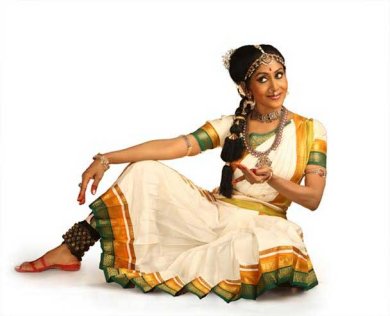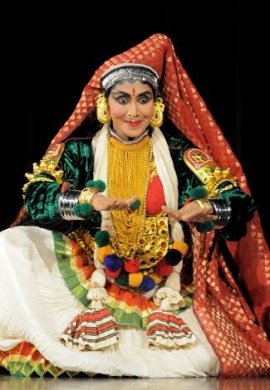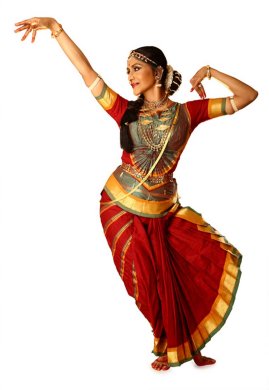
|
 |

|
 |
When I dance, I am at peace: Shanta Ratii - Vijay Shankar e-mail: vijaydance@gmail.com February 29, 2016 Singapore based Kuchipudi exponent Shantha Ratii performed for the multi-arts Kala Ghoda Festival that concluded on 17th Feb in Mumbai. Shanta reveals her growth as a versatile dancer performing three distinct classical dance styles, her experience as a performer, film maker, choreographer, teacher and the setting up of Shanta Ratii Initiatives in Singapore for the promotion and propagation of classical arts of India and Antara for the underprivileged and much more. Is anybody in your family into dance, music or the arts? I have a couple of nieces who dabble in dance. It is a passionate hobby for them as they are involved in other professions.  Your early formal education in academics and dance... I studied arts. In dance I started with Bharatanatyam and then Kathakali and later Kuchipudi and Kalaripayettu. Was it your dream to become a dancer? I never thought of dance as a profession ever, I guess, because growing up in Singapore dance-making was never looked upon as a profession. It is when I came to India and started performing in all the major festivals that I was looked upon as a professional. But for me I dance because that is what gives me life energy and keeps me close to my true self. It is an inner imperative. My foray into Kuchipudi, after Bharatanatyam, Kathakali and Martial Arts has given me the opportunity to play and enjoy the new works and experimentations that happens along the way. As we stand on the shoulders of many great gurus who handed down this legacy, we in turn hope to enrich it, while it enriches us, and pass it on to new generations of aspirants and audiences. The intense and rewarding experience of performing; the special joy of nurturing new and young talents; the motivation from audiences the world over; the inspiration from life itself - continues to make it a wholesome and fulfilling journey. The world of dance creates a Kairos space for me where time is non-sequential and qualitative in nature - offering me the sanctuary, fantasy and peace, I so treasure. It has also allowed me the curiosity, the creativity and, I dare say, the cheekiness with which I view life today. When I am dancing, I feel at peace.... like everything is working perfectly for me and through me... Which style of dance fascinates you the most and why? I love them all very much and each for a different reason - the regal geometry of Bharatanatyam, the high drama and larger than life aspect of Kathakali and the playfulness and spritely ebullience of Kuchipudi. It's like a mother loving her 3 children for what they are... difficult to compare, perhaps unnecessary to do so. A rose or an iris or a tulip... I wouldn't want to choose! Your experience with your mentors in dance... I was very fortunate to have done gurukul with my Kuchipudi guru Vempati Chinna Satyam. I did my initial training under gurus Raja - Radha Reddy and I was already performing before I went on to further my training under Dr. Vempati Chinna Satyam. Initially Vempati garu was hesitant to take me on as a student since I came from a different gharana, but when I performed an item for him he relented. It was yet another cathartic experience. Going from a luxury-oriented background and making do with the meagre means available, was a great learning process. I could have left at any time of my choosing but I am so glad I had an inner imperative that made me stay and grow as a person. For the first time, I discovered my strengths and learned to overcome my weaknesses. I also got the experience of gurukul with my Kathakali ashan (guru) Oyur Govinda Pillai. These are telling moments of my life that I treasure.  Did your parents encourage and support you? Initially they did. In fact, it was my father who would make me practise after dance class and correct every step, posture and gesture and also put together my costuming, make-up and hair-do etc. My sister apprenticed under him and later she took over. But when I was in my teens my father felt it was time to concentrate on studies and forget about dance. I couldn't comply. I thought I would wither away and die a slow death, and had to plead with him to relent. He did most reluctantly! When did you migrate to Singapore and are you happy living there? I was born and raised in Singapore. I then left to live in other parts of the world for 25 years, living in cities like Delhi, Baghdad, Penang, Chennai, New York, Trivandrum, Mumbai and London before returning to Singapore 5 years ago. I am absolutely happy to be back in Singapore, not because I didn't enjoy the other places - in fact I enjoy each place thoroughly. I feel it has enhanced me as a person and as an artiste, living and working in these different situations and circumstances. Many members of my family still live here and for me to be back with them is a great bonus. What is the performing arts scenario in Singapore? It is a highly buzzing art scene. There are many good institutions and talented dancers who do good work. Was it easy for you to get the support from Singapore Arts Council and what is the attitude of Singapore Government officials towards Indian classical dancers? The Singapore Arts Council which is a government agency lends great support to Indian and all other art endeavours be it visual arts, theatre, music, and literary works. Do you have other nationals participating in your dance productions? I have had Indians from India partaking in my productions besides Chinese Singaporeans adding value to the technical and PR aspects. About your Antara Foundation... I constituted Antara Foundation when I realized that the young and upwardly mobile in India were not even aware of their heritage. Mumbai being a film city, every aspect of life was touched by it, little realizing that even popular cultures like Bollywood draw their sap from the traditional arts, but should not be mistaken for the real thing. I felt that Indians should be aware and proud of their heritage. I endeavoured to give them the opportunity to experience, practice/perform the various traditions of visual and performing arts; to regenerate their spirit in unique ways that are more penetrative and lasting. I have now instituted SRI (Shantha Ratii Initiatives) in Singapore, which has a teaching wing (Bharatanatyam and Kuchipudi along with Yoga, pranayama and alignment and NLP which helps enormously in addressing oddities and the like in dance and gives good results in my experience), research and documentation and a performing wing. I am planning to start free classes for the underprivileged children. I feel strongly that they should not be deprived of this life enhancing activity which will help them in untold ways. I believe there is a lot of talent in Singapore that must be tapped and promoted. It is imperative that at this stage in my career I get to nurture young and promising talent. Besides, I would like to give free lessons to deserving and talented youngsters who cannot afford to pay for lessons. It would be a pity for them to miss out on this life enriching experience purely on economic grounds. Your experience as a filmmaker on Kathakali... The film is called "And Miles to Flow". It celebrates the kinship in spirit between Kathakali and other Asian dance-theatres like Noh and Kabuki theatres of Japan and Chinese Opera. I grew up being fascinated with Chinese Opera. When my father realised it he asked me if I would like to learn a similar form from Kerala called Kathakali, and that led to my tryst with Kathakali. Later when I saw Noh and Kabuki, it was yet another love affair! When I started research to find out more about the similarities between these forms I realised that there was a lacuna not only in print material but also on film. This was when I was living in New York. I felt the need to address this omission. l felt Kathakali hadn't gotten its dues as other similar forms. So even when my quest for funding to do the film failed as most of them felt it was too niche a subject, I was determined to do it somehow. I finally had to take personal loans to do it. Time was of essence because my Kathakali ashan was already 83 years old. Just when shooting schedules were set and my crew of 54 people arrived from various destinations, the camera crew in Chennai went on strike indefinitely! Finally when shooting began, the rains started and outdoor sequences suffered. Everything that could go wrong did go wrong as Murphy's Law said! It was a cathartic experience. Many lessons learnt and some wisdom gained! It was worth all that when the film got selected for the International Film Festival. It is a work close to my heart.  How socially relevant are your dance productions? My work of late veers towards ideological and concept based expressions. My recent production "Moksha Katha" addresses the relevance of Dharma in our lives. Like Hamlet said "...conscience makes cowards of us..." especially when we are compelled to make seemingly uncharitable decisions... should we examine it using moral and ethical lenses? Can undertaking our Dharma indemnify us from punishment or other consequences? My upcoming production is on the environmental degradation titled "Jwalath Jalam", world premier scheduled in July 2016 at Esplanade Theatres, Singapore, which will subsequently travel to India, USA and UK. It will have the physicality and imagery of the three styles of dance I am trained in, with the spoken word and multimedia and an original music score blending classical Indian music and contemporary soundscape. It is born out of the dire urgency of the situation which compels us to act as it has begun to affect our everyday life... to express it through my artistic voice and the unmistakable voice of children who are the inheritors of this planet ... I will be presenting "Moksha Katha" in Chennai in September, performing for International Dance Day for Utsav in April in Chennai and Soorya Festival in September. I also look forward to doing some new and interesting cross-cultural and inter-disciplinary work. Do you think marriage hinders the progress of dancers? It is not about marriage being a necessity but a natural corollary to life! I know of a few Indian dancers who are married and greatly supported by their husbands and in-laws too. It gives them the freedom and peace of mind to do their creative work and many travel extensively. Needless to say, there are numerous cases that work in the reverse. It is a pity... Some serious talent is lost to the art that way! Contact Shanta Ratii: shantarati@gmail.com Post your comments Unless you wish to remain anonymous, please provide your name and email id when you use the Anonymous profile in the blog to post a comment. All appropriate comments posted with name & email id in the blog will also be featured in the site. |